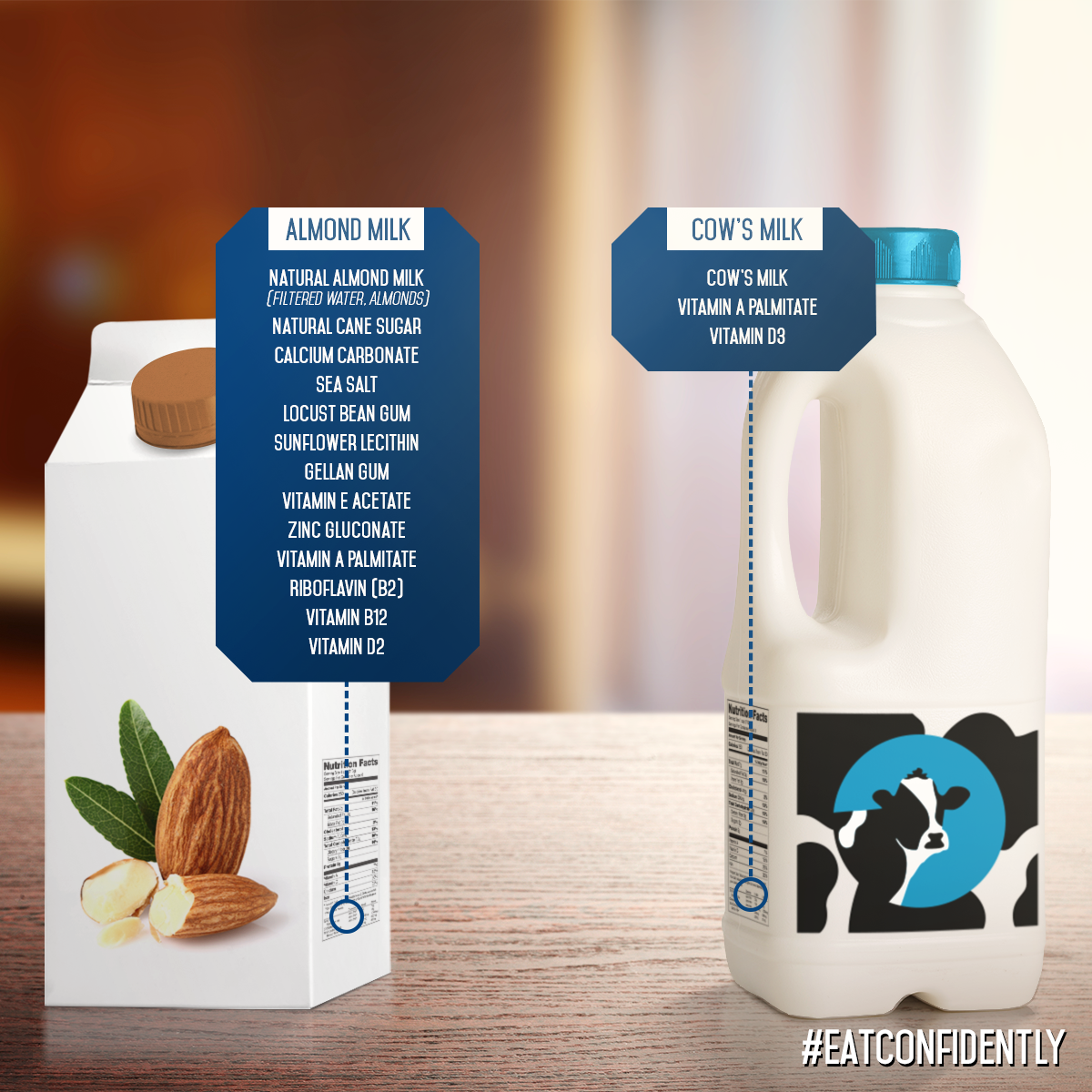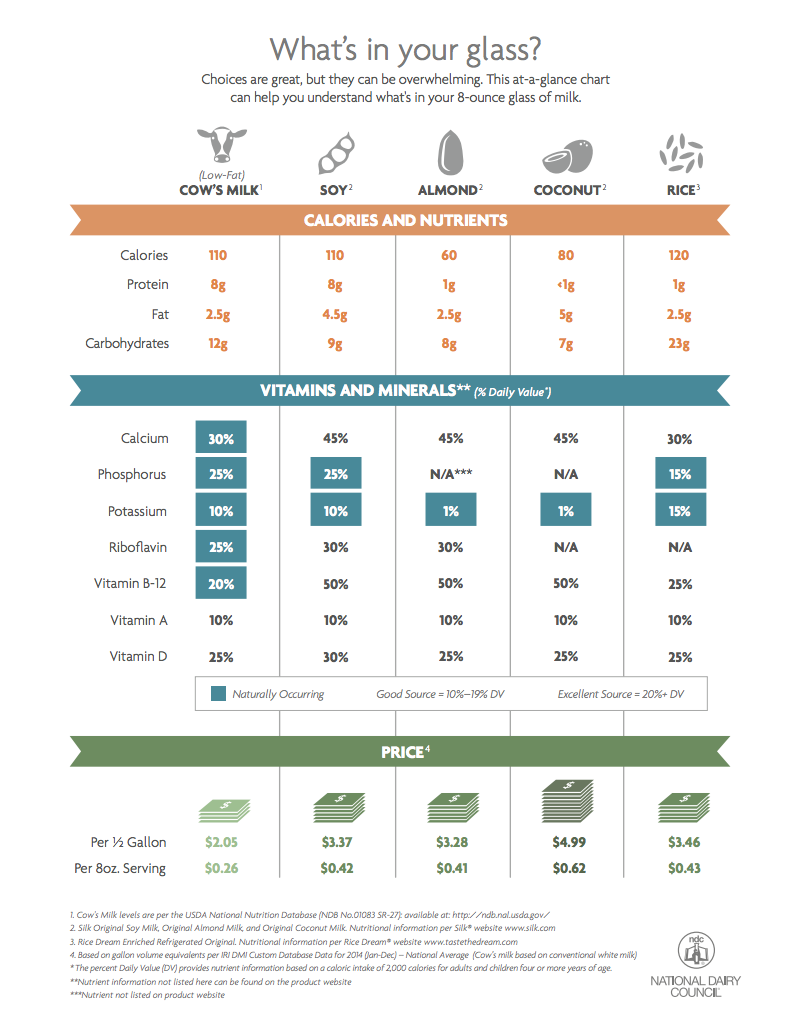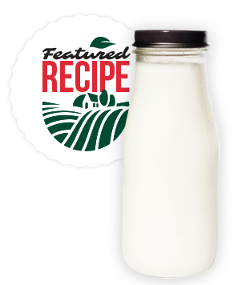Milk Imitators

Rice, soy and almond drinks are popular alternatives to traditional cow's milk that can be found in the dairy section of your grocery store. Whether you are choosing one of these beverages for health reasons or taste preference, it is important to note the nutritional differences so you can decide which is best for you. Milk imitators are fortified and designed to try to match the nutritional profile of cow’s milk. They are usually more expensive and often have long lists of added ingredients. In effect, milk imitators are not technically milk and are not naturally a nutritional equivalent to cow’s milk.
Milk from cows is the most naturally wholesome, nutritious drink out there, with numerous health benefits. Milk-drinkers tend to have better overall quality diets and without it, it’s much more difficult to get the adequate level of nutrients you need.
As the nation turns its attention to reducing calories, dairy foods account for just 10 percent of the calories in the American diet. A single glass of milk delivers a powerful package of nine essential nutrients, which is difficult to find in other foods. At just 25 cents per serving, milk is also the economical choice, offering more nutrients per penny than almost any other beverage option.
Milk imitators such as almond and soy contain 10 or more added ingredients including salt and even added sugar. Cow’s milk, on the other hand, is pure and simple, and that means no antibiotics too. In addition, milk provides the same great nutrient package every time, no matter which brand you choose. Milk imitators use fortification to mimic milk’s nutrient profile and there is no standard of identity across brands. Milk must conform to a federal standard of identity so you can be assured you are getting the same nutrient profile with every eight-ounce serving.

Why Milk Is Important
Milk from cows is commonly referred to as “nature’s most perfect food.” Few foods deliver dairy’s unique combination of nutrients in such an affordable, appealing and readily available way.
Sometimes milk is overshadowed because consumers are bombarded with so many beverage choices. However, many nutrition experts and health professional organizations – including the American Academy of Pediatrics and the National Medical Association – have long recognized the importance of three daily servings of dairy foods as part of a healthy, nutrient-rich diet. Americans currently consume about two servings of dairy per day, on average. Adding just one more serving of dairy can help fill some of America’s nutrient gaps, and eating more low-fat dairy foods has been shown to reduce the risk for high blood pressure, osteoporosis and certain cancers.
Milk contributes more calcium, vitamin D and potassium, three nutrients considered lacking in American diets, than any other food. Drinking milk substitutes can lead to gaps in calcium and other nutrients such as protein, phosphorous and B vitamins.
Lactose Intolerance
Lactose intolerance does not mean dairy avoidance. First, it’s important to understand whether you are sensitive, self-diagnosed or medically diagnosed. The vast majority of Americans actually fall under the first two categories. It can be confusing, but your dairy diet doesn’t have to be all or nothing. If you’re considering a milk imitator because you think you might be lactose intolerant, consider lactose-free dairy products. They provide the same nutritional benefits found in traditional dairy foods, except the lactose (milk sugar) is already broken down for you. You can still enjoy dairy daily since many milks, yogurts and cheeses, such as cheddar and Swiss, do not contain lactose, but still provide those essential nutrients. Check out the labels, consider incorporating small portions of dairy into your diet and talk to your doctor or registered dietitian.
Calcium
Ounce for ounce, milk is by far the best source of calcium for the money. Milk alternatives are poor natural sources of calcium, so they must be fortified to be calcium-rich. Few foods provide such a concentrated source of calcium as milk and milk products. Depending on the brand, alternative beverage companies use different methods to fortify their products, and there is no federal standard of the nutrient profile of the product. Read the label carefully and be on the lookout for a long list of unfamiliar ingredients.
Calcium Absorption
A beverage-maker’s claim that its drink has “twice the calcium” of milk doesn’t mean you’ll benefit from it. When considering nondairy beverages, it’s important to keep in mind that their fortification does not guarantee that they are nutritionally equivalent to milk. This is because the bioavailability of calcium forms and sources varies. While soy beverages are considered part of the “Milk Group,” they do not naturally contain all of the nutrients found in cow’s milk and require fortification to mimic its nutrient package. Plus, with food costs going up across the board, soy beverages tend to be more expensive than cow’s milk.
Research shows that ounce for ounce, cow’s milk is one of the best sources of calcium for your money. An eight-ounce glass of milk provides eight times more naturally occurring protein than a glass of almond beverage. In fact, milk imitators contain little or no high quality protein. To obtain the amount of calcium absorbed from one cup of milk, an individual would have to consume eight cups of spinach, nearly five cups of red beans or 2 1/4 cups of broccoli. Vegan sources of calcium may be less bioavailable, making it more difficult for vegans to meet calcium recommendations.

FeaturedRecipe
Hazelnut and Chocolate Oatmeal Cookies
Try these soft and flavorful oatmeal, chocolate, and hazelnut cookies, with the crunch of hazelnuts and the creamy spread of chocolate. Perfect for quick snacks, desserts, or sharing with the family—no baking required.
Thanks to our friends at Fuertes Con Leche for the recipe.

FeaturedRecipe
Pumpkin Fluff

FeaturedRecipe
Savory Pumpkin Dip








